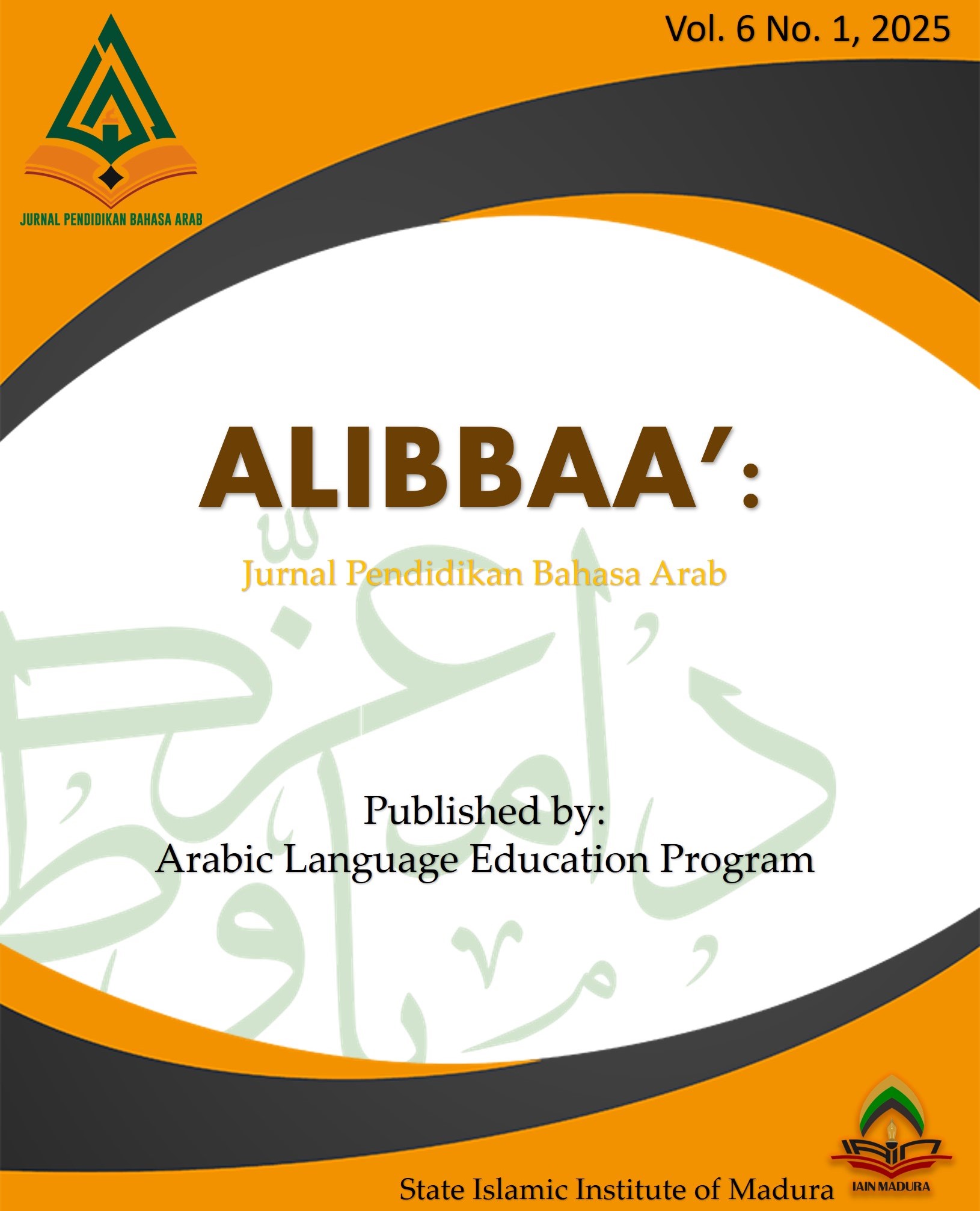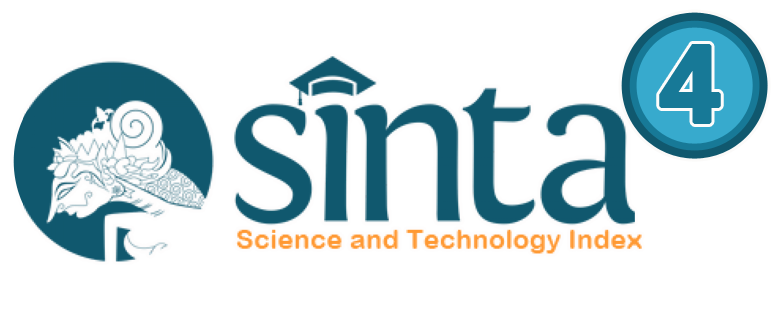TOAFL.com: A CEFR-Based Simulation Platform for Learning Al-Arabiyah Lil Akadimiyah Among Indonesian Students
 Abstract views: 74
,
Abstract views: 74
,
 pdf downloads: 111
pdf downloads: 111
Abstract
This study aims to analyze the application of Toafl.com as a simulation platform for learning Al-Arabiyah lil Akadimiyah based on CEFR (Common European Framework of Reference for Languages) to support the Arabic language skills of students of the Interdisciplinary Islamic Studies Program (SII) Nahdlatul Ulama University (UNU) Yogyakarta. The research method uses a qualitative-descriptive approach with data collection techniques in the form of observation, interviews, and documentation for half a semester. The subjects of this study were class 3B students of the Interdisciplinary Islamic Studies Program (SII) UNU Yogyakarta. The results of the study indicate that the application of Toafl.com can help students understand question patterns, improve linguistic skills, and help students understand various Arabic language skills, including Istima' (listening), Kalam (speaking), Qira'ah (reading), and Kitabah (writing), according to the CEFR level (A1-C2). In addition, Toafl.com is also able to provide direct feedback, making it an effective tool in identifying weaknesses and potential improvements in students' Arabic language skills. This study recommends a wider integration of Toafl.com into the Arabic language learning curriculum at the college level.
Downloads
References
Amalia, Nabila Nailil, M Abdul Hamid, and Zakiyah Arifa. “Analysis of the Arabic Language Textbook for Junior High School from the Perspective of the Education , Standards , Curiculum , and Assesment Agency ( BSKAP ).” Alibbaa’: Jurnal Pendidikan Bahasa Arab 5, no. 2 (2024).
Annisa, maryam nur. “Analisis Kebutuhan Dan Tantangan Dalam Pembelajaran Bahasa Arab Sebagai Bahasa Asing Di Pendidikan Tinggi.” Ejournal 2, no. 2 (2023): 313–28.
Barmawi, Mohammad. LULUS TOAFL DENGAN MUDAH DAN MEMUASKAN. 1st ed. Yogyakarta: Diva Press, 2011.
Belva Saskia Permana, Lutvia Ainun Hazizah, and Yusuf Tri Herlambang. “Teknologi Pendidikan: Efektivitas Penggunaan Media Pembelajaran Berbasis Teknologi Di Era Digitalisasi.” Khatulistiwa: Jurnal Pendidikan Dan Sosial Humaniora 4, no. 1 (2024): 19–28. https://doi.org/10.55606/khatulistiwa.v4i1.2702.
Dewi+Rika+Juita.pdf, et al. “Pengembangan Program Pembelajaran Berbasis Kompetensi Untuk Meningkatkan Keterampilan Berbahasa Asing Di Perguruan Tinggi.” SOSIOHUMANIKA: Jurnal Pendidikan Sains Sosial Dan Kemanusiaan 8, no. 1 (2015): 131–40.
Euis Ernawati. “Perencanaan Pembelajaran Bahasa Arab.” Arabiyat: Jurnal Pendidikan Bahasa Arab Dan Kebahasaaraban 5, no. 1 (2014): 60.
Ibtisam Abdullah, Ashinida Aladdin, and Mohamad Azwan Kamarudin. “Pendekatan Pengajaran Dan Pembelajaran Kemahiran Bahasa Arab Berteraskan Standard CEFR.” Webinar Kebangsaan Isu P&P Bahasa Arab IPT 2020, no. January (2021).
Khasanah, Ruliana. “Kerangka Pengajaran Bahasa Asing Level A1-A2 Dalam Standar CEFR (Studi Pendekatan Filsafat Bahasa).” Tesis UIN Sunan Kalijaga, no. 2018 (2019): 32. https://www.academia.edu/download/82217590/JURNAL_KERANGKA_PENGAJARAN_BAHASA_ASING_LEVEL_A1_dikonversi.pdf.
Khuluq, Muchsinul, Mamluatul Hasanah, Muasshomah Muasshomah, and Nurul Imamah. “Mobile-Assisted Language Learning Apps: The Analysis of Duolingo’s Content Using ACTFL Standarization.” Khuluq | Al-Ta’rib : Jurnal Ilmiah Program Studi Pendidikan Bahasa Arab IAIN Palangka Raya (December 5, 2024). https://doi.org/10.23971/altarib.v12i2.8806.
Kosim, Nanang, Ade Arip Ardiansyah, and Hilda Saripatul Hikmah. “The Use of The Task-Base Language Teaching ( TBLT ) Method to Improve Learning Outcomes of Arabic Language Skills” 5, no. 2 (2024).
M Sholih Salimul Uqba, Nur Hasaniyah, Abdul Muntaqim Al Anshory, and Adam Mudinillah. “Students’ Perception of Translation Software: A Case Study in the Bachelor and Master Programs of Arabic Education.” Alibbaa’: Jurnal Pendidikan Bahasa Arab 5, no. 1 (2024): 82–97. https://doi.org/10.19105/ajpba.v5i1.11555.
Ma’arif, Ahmad Syamsul. “Sighah Ikhtibarat Al-’Arabiyyah Fi Dui Al-Ikhtibar Al-Mutqn (TOAFL).” Jurnal Al Bayan: Jurnal Jurusan Pendidikan Bahasa Arab 9, no. 2 (2018): 160–73.
Muhajir, Mohamad, and Mohamad Naim Madjid. “The Importance of TOAFL in Improving the Language Skills of Arabic Language Education of Sixth Semester Students at Universitas Muhammadiyah Yogyakarta,” no. January (2021). https://doi.org/10.2991/assehr.k.210120.132.
Mustofa+et.+al+MEMBANGUN+PENDIDIKAN+ISLAM+DENGAN+HIKMAH+DAN+KETELADANAN.pdf.
Qodri, Muhammad. “Problematika Pembelajaran TOAFL Pada Mahasiswa Fakultas Ilmu Tarbiyah Dan Keguruan UIN Sulthan Thaha Saifuddin Jambi.” Loghat Arabi : Jurnal Bahasa Arab Dan Pendidikan Bahasa Arab 1, no. 1 (2020): 1. https://doi.org/10.36915/la.v1i1.1.
Rika Widianita, Dkk. “TOAFL test item analysis” AT-TAWASSUTH: Jurnal Ekonomi Islam VIII, no. I (2023): 1–19.
Robbani, A. Syahid, Talqis Nurdianto, Ahmad Zaki Annafiri, Ahmad Muzayyan Haqqy, and Irfan Irfan. “Tren Penelitian Dan Tantangan Penerapan Common European Framework of Reference for Languages (CEFR) Di Indonesia.” Diglosia: Jurnal Kajian Bahasa, Sastra, Dan Pengajarannya 6, no. 4 (2023): 1011–26. https://doi.org/10.30872/diglosia.v6i4.736.
Ruminar, Hafida, Dian Islami Prasetyaningrum, Rizkiana Maharddhika, and Mushoffan Prasetianto. “Pelatihan Dan Simulasi Toefl Sebagai Upaya Mencapai Nilai Yang Ditargetkan.” Dharmakarya 12, no. 1 (2023): 122. https://doi.org/10.24198/dharmakarya.v12i1.43061.
Salam, Muhammad Yusuf, Suharmon, Afzalia Fusca Zela, Della Helviza, and Rifki Zaitul Ikhlas. “Pengembangan Panduan Tes Bahasa Arab Berbasis TOAFL Di Madrasah Aliyah Negeri 2 Padang Panjang Menggunakan Aplikasi Lectora Inspire, Quizizz, Dan Kahoot.” Jurnal Teknologi Pendidikan 12, no. 2 (2023): 175–93.
Sari, Renit Renita, and Khizanatul Hikmah. “Al Mi ’ Yar : Jurnal Ilmiah Pembelajaran Bahasa Arab Dan Kebahasaaraban Implementasi Kegiatan Pembelajaran Bahasa Arab Pada Boarding School SMA Muhammadiyah 2 Sidoarjo” 7, no. 2 (2024): 717–25.
Sarnoto, Ahmad Zain, Rachmat Hidayat, Lukman Hakim, Khusni Alhan, Windy Dian Sari, and Ika Ika. “Analisis Penerapan Teknologi Dalam Pembelajaran Dan Dampaknya Terhadap Hasil Belajar.” Journal on Education 6, no. 1 (2023): 82–92. https://doi.org/10.31004/joe.v6i1.2915.
Sudaryanto, Sudaryanto, and Pratomo Widodo. “Common European Framework of Reference for Languages (CEFR) Dan Implikasinya Bagi Buku Ajar BIPA.” Jurnal Idiomatik: Jurnal Pendidikan Bahasa Dan Sastra Indonesia 3, no. 2 (2020): 80–87. https://doi.org/10.46918/idiomatik.v3i2.777.
Sugiyono. Metode Penelitian Kualitatif, Kuantitatif, Dan RnD. 3rd ed. Bandung, 2021.
Ulin Nuha, Muhammad Afthon, and Faedurrohman Faedurrohman. “Manajemen Perencanaan Kurikulum Bahasa Arab (Tinjauan Ontologi, Epistemologi Dan Aksiologi).” Al-Muyassar: Journal of Arabic Education 1, no. 2 (2022): 203. https://doi.org/10.31000/al-muyassar.v1i2.6488.
Wulandari, Nawang. “Development of TOAFL Media Based on Learning Management System For IAIN Metro Students | Pengembangan Media TOAFL Berbasis Learning Management System Bagi Mahasiswa Di IAIN Metro.” Mantiqu Tayr: Journal of Arabic Language 3, no. 2 (2023): 120–34. https://doi.org/10.25217/mantiqutayr.v3i2.3433.
Zaimah, N R, R K W Estu, S F Hidayah, and ... “Harnessing Gemini for Arabic Mastery: Educators’ and Learners’ Views.” Alibbaa’: Jurnal … 5, no. 2 (2024). http://ejournal.iainmadura.ac.id/index.php/alibbaa/article/view/14808.
Authors who publish with this journal agree to the following terms:
a. Authors retain copyright and grant the journal right of first publication with the work simultaneously licensed under a Creative Commons Attribution License that allows others to share the work with an acknowledgement of the work's authorship and initial publication in this journal.
b. Authors are able to enter into separate, additional contractual arrangements for the non-exclusive distribution of the journal's published version of the work (e.g., post it to an institutional repository or publish it in a book), with an acknowledgement of its initial publication in this journal.
c. Authors are permitted and encouraged to post their work online (e.g., in institutional repositories or on their website) prior to and during the submission process, as it can lead to productive exchanges, as well as earlier and greater citation of published work (See The Effect of Open Access).
Alibbaa': Jurnal Pendidikan Bahasa Arab have CC-BY-SA or an equivalent license as the optimal license for the publication, distribution, use, and reuse of scholarly work.
In developing strategy and setting priorities, Alibbaa': Jurnal Pendidikan Bahasa Arab recognize that free access is better than priced access, libre access is better than free access, and libre under CC-BY-SA or the equivalent is better than libre under more restrictive open licenses. We should achieve what we can when we can. We should not delay achieving free in order to achieve libre, and we should not stop with free when we can achieve libre.

Alibbaa': Jurnal Pendidikan Bahasa Arab is licensed under a Creative Commons Attribution 4.0 International License
You are free to:
- Share — copy and redistribute the material in any medium or format
- Adapt — remix, transform, and build upon the material for any purpose, even commercially.
- The licensor cannot revoke these freedoms as long as you follow the license terms.











